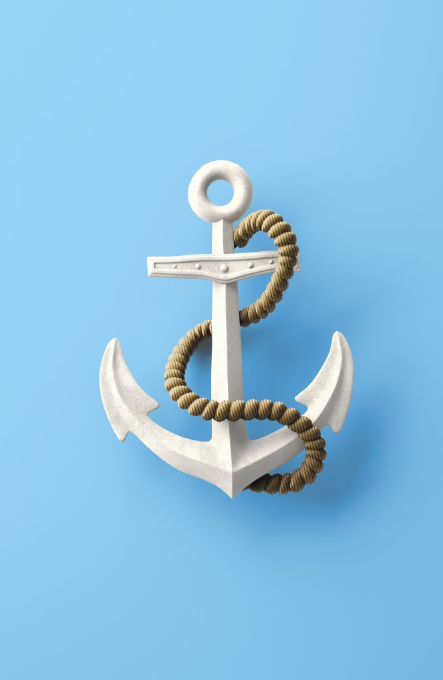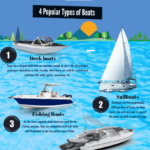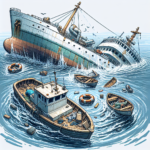So, you’ve finally gotten yourself a boat, huh? That’s great! But now comes the tricky part: anchoring it properly. Whether you’re planning a leisurely day of fishing or want to soak up some sun on a quiet cove, knowing how to anchor your boat is crucial. After all, you don’t want your boat drifting away or banging against other vessels. In this article, we’ll walk you through the essential steps and tips on how to properly anchor a boat, ensuring a safe and enjoyable experience every time you set sail.
Choosing the Right Anchor
Anchor Type
When it comes to selecting the right anchor for your boat, there are various types to choose from. The most common types include fluke anchors (also known as Danforth anchors), plow anchors, and grapnel anchors. Fluke anchors are popular for their lightweight design and excellent holding power in sandy or muddy bottoms, making them a versatile choice for recreational boaters. Plow anchors, on the other hand, are known for their ability to dig into various seabeds, such as clay or grass, providing reliable holding. Grapnel anchors are often used for smaller boats or as a secondary anchor due to their compact size and ease of storage.
Anchor Size and Weight
Selecting the appropriate size and weight for your anchor is crucial to ensure its effectiveness in securing your boat. The general rule of thumb is to choose an anchor that weighs approximately one pound for every foot of your boat’s length. However, this rule can vary depending on the vessel’s weight, windage, and the type of anchor being used. It is always a good idea to consult the manufacturer’s recommendations or seek advice from experienced boaters to determine the ideal size and weight for your specific boat.
Anchor Material
The material of the anchor plays a significant role in its performance and longevity. Anchors can be made from materials such as galvanized steel, stainless steel, or aluminum. Galvanized steel anchors are commonly used due to their durability and resistance to rust and corrosion. Stainless steel anchors offer similar benefits but are often preferred for boats that operate in saltwater environments. Aluminum anchors, although lightweight and easy to handle, may not be as sturdy as their steel counterparts and are more prone to bending or breaking under excessive loads. Consider the conditions in which you will be boating and choose an anchor material that best suits your needs.
Preparing the Boat for Anchoring
Clearing the Deck
Before dropping anchor, it is essential to clear the deck of any potential obstacles that may interfere with the anchoring process. Remove any items, such as fishing gear, water toys, or loose equipment, that could obstruct the movement of the anchor or anchor line. Ensure that the deck is free from clutter to prevent any accidents or entanglements during the anchoring procedure.
Securing Loose Items
While at anchor, your boat may be exposed to wind and currents that can cause it to sway or rock. To prevent damage or loss of personal belongings, take the time to secure loose items both on the deck and inside the cabin. Ensure that fishing rods, chairs, and coolers are properly stowed, and cabinet doors and drawers inside the cabin are securely locked. By securing loose items, you can enjoy your time at anchor without the worry of things shifting or falling overboard.
Deploying Fenders
Deploying fenders is an essential step in preparing your boat for anchoring, especially if you plan to anchor near other vessels or a dock. Fenders act as a buffer between your boat and any potential contact, protecting your hull from damage. Attach the fenders to the appropriate locations on your boat, such as the sides or bow, using fender lines. It is recommended to have a sufficient number of fenders to adequately protect your boat’s vulnerable areas. By deploying fenders, you can anchor with peace of mind, knowing that your boat is safeguarded from potential collisions.
Finding the Right Location
Understanding the Environment
Before anchoring, it is vital to have a good understanding of the surrounding environment. Take note of any potential hazards, such as rocks, reefs, or shallow areas, that could pose a threat to your boat’s safety. Familiarize yourself with the local currents, tides, and wind patterns to ensure that you select an anchorage that provides adequate protection and stability. By understanding the environment, you can make informed decisions and choose an anchoring location that minimizes risks.
Considering Anchorages
When searching for the right location to anchor your boat, consider the different anchorages available. An anchorage refers to an area where boats can safely drop anchor for various purposes, such as overnight stays or recreational activities. Some anchorages may be designated by local authorities or marked on nautical charts, indicating their suitability for anchoring. Consider factors such as depth, bottom composition, and protection from wind and waves when assessing potential anchorages. Researching and choosing established anchorages can provide added peace of mind, knowing that other boaters have successfully anchored there before.
Checking Navigational Charts
Navigational charts are invaluable tools for boaters as they provide detailed information about the waterways, including depths, underwater structures, and potential hazards. Before anchoring, review the relevant navigational charts for your boating area to identify suitable anchorages. Pay attention to any special considerations, such as restricted areas or recommended anchoring locations. Navigational charts can help you plan your route to the desired anchorage and ensure that you navigate safely to your chosen location.
Anchoring Technique
Positioning the Boat
Once you have found the ideal anchoring location, it is crucial to position your boat correctly before dropping the anchor. Take into account the wind, current, and any other factors that may affect the boat’s position. Approach the anchorage at a slow speed and align your boat in the desired position, considering any surrounding vessels or obstructions. Take note of any landmarks or reference points onshore to assist you in visually confirming your boat’s position once anchored.
Lowering the Anchor
Lowering the anchor should be done in a controlled manner to ensure it reaches the seabed without tangling or dragging along the boat’s hull. Slowly let out the anchor rode while applying gentle tension to prevent it from free falling. Avoid releasing the anchor too quickly or forcefully, as it can lead to rope or chain snarling and reduce the anchor’s ability to set properly. Maintain a steady pace and communicate with crew members to ensure everyone is aware of the anchoring process.
Setting the Anchor
Once the anchor has reached the bottom, it needs to set or dig into the seabed to establish a secure hold. Gently reverse the boat’s engines to put tension on the anchor rode and encourage the anchor to embed itself. Observe the movement of the anchor rode; if it remains taut and the boat starts to slowly veer back, it indicates that the anchor is setting. Allow the anchor to set for a few moments while maintaining light tension on the rode. If needed, let out additional scope to improve holding power before securing the anchor line.
Securing the Anchor
Securing the Anchor Line
After the anchor has set properly, it is essential to secure the anchor line to prevent accidental dislodging or the formation of anchor rode knots. Use a reliable and properly sized cleat or other anchoring device on the boat to secure the anchor line firmly. Make sure the cleat is large enough to accommodate the diameter of the rope or chain without causing it to slip or loosen. Properly securing the anchor line reduces the risk of the anchor unintentionally releasing, providing peace of mind during your time at anchor.
Using Anchor Chain
When anchoring, using an anchor chain can provide additional weight and help improve the anchor’s ability to set and hold. Connect the anchor line to the anchor chain using a reliable shackle or other secure connection. The length of the anchor chain will depend on various factors such as water depth, bottom conditions, and boat size. A general guideline is to have a chain length that represents at least one boat length. Anchor chains also help reduce strain on the anchor line and minimize the potential for chafing or damage.
Attaching Anchor Markers
Attaching anchor markers to the anchor line can serve as a visual indicator of the anchor’s position, especially if you need to adjust or retrieve the anchor later. Use brightly colored floats or buoys that are easily visible on the water’s surface. Attach the anchor marker at a point on the anchor line that allows it to remain above the water when the anchor is completely set. Anchor markers help you keep track of the anchor’s location and prevent accidental entanglement with other vessels.
Monitoring and Adjusting
Monitoring for Drift
While at anchor, it is essential to stay vigilant and monitor your boat’s position for any signs of drift. Changes in wind direction, current strength, or tidal activity can cause your boat to shift its position, potentially leading to unsafe situations. Regularly check your boat’s alignment with landmarks and reference points onshore. Pay attention to the movement of other anchored vessels or floating objects in the area, as they can serve as indicators of changes in conditions. By monitoring for drift, you can take prompt action to avoid collisions or anchor dragging.
Adjusting Anchor Position
If you notice that your boat is drifting or not holding its position as desired, it may be necessary to adjust the anchor’s placement. Carefully assess the conditions and decide whether to re-anchor in a different location or adjust the existing anchor setup. If choosing to re-anchor, follow the anchoring technique described earlier to secure the boat in the new position. Alternatively, try letting out additional scope or adjusting the tension on the anchor line to improve holding power. By making the necessary adjustments, you can ensure a safer and more secure anchoring experience.
Checking Anchor Tension
Regularly checking the tension on the anchor line is crucial to ensure that the anchor remains securely set. By visually assessing the angle of the anchor line, you can determine if it is too loose or overly taut. An excessively tight anchor line may indicate an excessive load on the anchor, requiring adjustment or additional measures to secure the boat. Conversely, a slack anchor line suggests a potential loss of holding power, requiring closer inspection or possible re-anchoring. Maintaining proper anchor tension is key to a successful and worry-free anchoring experience.
Retrieving the Anchor
Preparing for Retrieval
Before retrieving the anchor, prepare the boat and crew for the process. Remove any fenders and stow them securely, ensuring that they are not obstructing the retrieval of the anchor. Communicate with the crew, assigning specific roles and responsibilities to ensure a safe and efficient retrieval. Ensure that the anchor line is clear of any tangles or obstructions that may impede the retrieval process. By preparing in advance, you can streamline the retrieval process and minimize potential risks.
Pulling Up the Anchor
To retrieve the anchor, slowly bring the boat closer to the anchor line while maintaining light tension. As the boat moves forward, the anchor line should begin to rise vertically from the seabed. Avoid pulling up the anchor line too quickly or with excessive force, as it may cause the anchor to become lodged or damage the boat’s hull. Gradually increase the tension on the anchor line, pulling it up steadily while ensuring that the anchor is dislodging smoothly from the bottom. Coordinate with crew members to ensure everyone’s safety throughout the retrieval process.
Stowing the Anchor
Once the anchor is fully retrieved, it is crucial to stow it properly to prevent damage or injuries. Rinse off any accumulated debris or sediment from the anchor to maintain its performance and prevent corrosion. Securing the anchor inside an anchor locker or designated storage area will prevent it from shifting during the boat’s movements. Ensure that the anchor line is neatly coiled or stowed to prevent entanglement or trip hazards. By properly stowing the anchor, you can maintain its longevity and avoid potential accidents or damage.
Anchoring Etiquette
Respecting Other Boaters
When anchoring in shared anchorages, it is essential to respect other boaters’ space and priorities. Do not anchor too close to other vessels, as this can potentially restrict their maneuverability or cause collisions. Be aware of your boat’s swing radius and adjust your anchoring position accordingly to prevent encroachment on other boaters’ space. Keep noise levels to a minimum when anchoring near others, respecting the peacefulness of the anchorage. By practicing good etiquette and respecting fellow boaters, you contribute to a positive and enjoyable anchoring experience for everyone.
Obeying Local Regulations
Different jurisdictions may have specific regulations and guidelines concerning anchoring in certain areas. It is crucial to be aware of and adhere to these regulations to avoid fines or legal issues. Familiarize yourself with local anchoring restrictions, such as no-anchoring zones, restricted areas, or time limitations. Some areas may require permits or impose specific anchoring techniques to protect sensitive marine ecosystems. By obeying local regulations, you demonstrate responsible boating and help preserve the environment for future generations.
Leaving No Trace
To minimize your impact on the environment and preserve the beauty of the waterways, it is important to practice Leave No Trace principles when anchoring. Avoid throwing trash or other debris overboard, and properly dispose of waste at designated facilities onshore. Be mindful of the marine life and refrain from dropping anchor on coral reefs or sensitive habitats. Use environmentally friendly cleaning products and minimize the use of harsh chemicals that can harm the marine ecosystem. By leaving no trace, you contribute to the sustainability and health of our oceans and waterways.
Common Anchor Problems
Dragging Anchor
One of the common challenges faced while anchoring is the anchor dragging, which can occur when the anchor loses its grip on the seabed and fails to hold the boat in place. This can happen due to factors such as sudden changes in wind or current direction, unsuitable anchor type or size, or an inadequate anchor setting. To prevent anchor dragging, regularly monitor your boat’s position and react promptly to any signs of drift. If anchor dragging occurs, consider re-anchoring in a different location or adjusting the anchor setup to improve holding power.
Getting Caught on Obstacles
Obstacles on the seabed, such as rocks, coral, or debris, pose a risk of entangling or fouling the anchor during deployment or retrieval. Getting caught on such obstacles can result in a frustrating and potentially dangerous situation. To minimize the chances of this occurring, carefully choose anchoring locations away from known obstacles or hazards. Utilize navigational charts and local knowledge to identify potential obstructions. If the anchor does become stuck, use cautious boat maneuvers or try changing the pull angle to free the anchor. In severe cases, it may be necessary to dive and manually free the anchor or seek assistance from professional salvage services.
Anchor Fouling
Anchor fouling refers to the accumulation of debris, seaweed, or marine organisms on the anchor or anchor line, hindering its effectiveness. Fouling can reduce the anchor’s ability to dig into the seabed and compromise its holding power. To prevent anchor fouling, consider deploying a trip line, which is a separate line attached to the crown of the anchor and floats to the surface. By pulling on the trip line, you can break loose any entangled debris from the anchor. Regularly inspect and clean the anchor and anchor line to remove any accumulated fouling, ensuring optimal performance.
Additional Tips and Safety Precautions
Using Anchor Swivels
Anchor swivels can enhance the functionality of your anchoring system by allowing the anchor to rotate freely without twisting or kinking the anchor line. This can be particularly beneficial in high current or windy conditions. Install a swivel between the anchor line and anchor chain or directly between the anchor line and anchor to ensure smooth rotation and maintain proper tension. Remember to regularly inspect and lubricate the swivel to maintain its performance and prevent any potential issues.
Regularly Inspecting Anchor Gear
As with any equipment on your boat, it is essential to regularly inspect and maintain your anchor and associated gear. Check for signs of wear, such as rust, corrosion, or bent components, that could compromise the anchor’s effectiveness. Ensure that the anchor line and chain are in good condition and free from fraying or weakening. Clean and lubricate moving parts, such as shackles or swivels, to ensure smooth operation. By conducting routine inspections, you can identify any potential problems early on and address them promptly, ensuring a reliable and safe anchoring experience.
Emergency Procedures
While anchoring, it is crucial to be prepared for unexpected emergencies or adverse weather conditions. Develop an emergency plan that includes procedures for severe weather, equipment failure, or medical emergencies. Ensure that all crew members are familiar with their responsibilities and know how to operate safety equipment, such as life jackets or emergency beacons. Have emergency contact information readily available and communicate your planned itinerary with a reliable shore contact. By being prepared, you can minimize risks and respond effectively to unexpected situations while at anchor.





